Photo of the Day
 Tuesday, October 19, 2010 at 02:12PM
Tuesday, October 19, 2010 at 02:12PM

Leopard in a Tree
Mala Mala Game Reserve, South Africa. August 2010
Nikon D700, 200-400mm f/4, 1/400 @ f/4, ISO 3200
 Leopard,
Leopard,  Mala Mala,
Mala Mala,  South Africa in
South Africa in  Photo of the Day
Photo of the Day
I am an avid adventurer, conservationist, teacher, and outdoor photographer whose photography celebrates the African landscape and its rich wildlife, people, and culture. My photographic safaris allow my travelers to not only enhance their understanding of photography, lighting, and wildlife, but to develop a life-long admiration for Africa ‘s beauty and culture.
Banana Republic recently used my photographs as the cornerstone of their Urban Safari campaign, and my images were seen in all 750 stores around the globe, as well as in their billboards, catalogs and annual report. I was also the winner of the BBC Wildlife Photographer of the Year in the ‘Wild Places’ category in 2008 and a highly commended in the ‘Creative Visions of Nature’ category in 2007.
I launched Gura Gear in 2008, in an attempt to deliver lightweight camera bags to the market. I was looking for a lightweight camera bag to hold all of my photographic gear, and there was nothing desirable on the market that suited my needs. After spending 2 years with many prototypes, the Gura Gear Kiboko bag was born. More products are now available on the Gura Gear web site.
 Tuesday, October 19, 2010 at 02:12PM
Tuesday, October 19, 2010 at 02:12PM

Leopard in a Tree
Mala Mala Game Reserve, South Africa. August 2010
Nikon D700, 200-400mm f/4, 1/400 @ f/4, ISO 3200
 Leopard,
Leopard,  Mala Mala,
Mala Mala,  South Africa in
South Africa in  Photo of the Day
Photo of the Day  Monday, October 18, 2010 at 01:14PM
Monday, October 18, 2010 at 01:14PM

Albuquerque Hot Air Balloon Fiesta, October 2010
Nikon D700, 28-300mm lens @ 28mm, 1/1000 @ f/5.6, ISO 320
 Sunday, October 17, 2010 at 10:34PM
Sunday, October 17, 2010 at 10:34PM
All the best,
Andy, Seth and John Paul
 Antarctica,
Antarctica,  Workshop in
Workshop in  News,
News,  Workshops
Workshops  Monday, September 13, 2010 at 08:26AM
Monday, September 13, 2010 at 08:26AM Today was a day for giraffes and rhino, and when it comes to giraffe photographs I just don’t have enough great shots of my most favorite of mammals. One of the challenges when photographing giraffes is related to composition: a giraffe’s neck is so long that most of the time the long neck is intersected by a converging line in the background, the horizon. This doesn’t sound like a big deal, but the human brain has a difficult time with converging lines. An image that has discordant elements can often lead to an unsettling feeling to a viewer, even though the viewer cannot explain why they don’t respond positively to an image. Well, converging lines typically are not helpful in a photograph, yet these converging lines are omnipresent in nature photographs. Nature is inherently very messy. It is our job as nature photographers to try and make order out of chaos.
I have so many giraffe photographs in my library, yet very very few of them ‘work’ for me. Most of the time it is difficult to explain why, but an easy answer is that converging lines often spoil a photograph. Giraffes are typically found near their food source (duh), which are typically trees that are at least 3 meters tall. These trees often interfere with a clean shot. When I find giraffes away from their food source, they are either walking to another food source or water. My favorite photos of giraffes are when they are on the open plains, away from trees and bushes that can hide some or all of these majestic creatures.
Ok, on to today’s images. We spent some time photographing some giraffes at a water hole, and one of the challenges when photographing drinking giraffes is finding the best position to shoot from. If a giraffe gets nervous while drinking, it will stop drinking, lift its head and walk away. So one has to find the best position prior to drinking. My goal was to find a position that would accentuate the water that drips from the mouth of the giraffe, after the head comes up from the water. This requires side lighting to adequately illuminate the ‘slobber’, but we couldn’t line up the vehicle to make that work. The other challenge with this approach is that the giraffe head comes up from the water very very quickly, and would require at least 1/640 shutter speed to freeze the action. The background was fairly close behind our subject, and this also makes for a compositional challenge. The farther the background is away from the subject, the easier it is to blur the background. This can be a big deal, because a giraffe who is leaning down the drink often needs 6 to 10 feet of depth of field. If you are using a 400mm lens from 75 feet away, this may mean that you need to be shooting at f/11, f/14 or perhaps f/16 to make it work. These f/stops make blurring the background difficult if the background is too close to the giraffe.
Ok, enough technobabble. Here are some quick, unprocessed photos from today.
Note: All images in these daily blog postings are very very rough edits of the things we have seen, and I often omit the photographs that take too much time to process. I don’t take much time off during the day, as I am working with people with their photographic needs. All of my images in these posts will have to be re-processed when I get back home, and they are only included in these blog entries for illustration purposes only.
 Giraffe drinking water
Giraffe drinking water

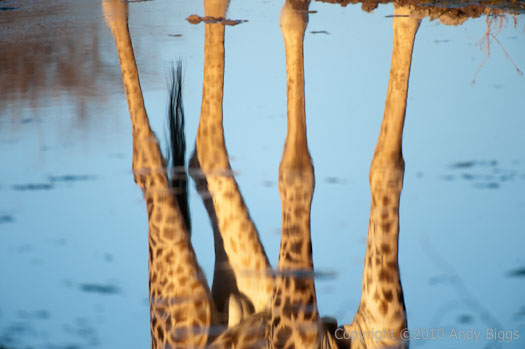
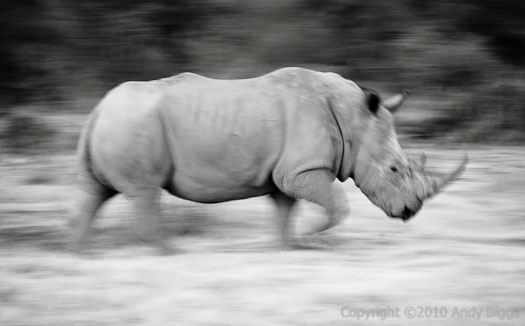
 Giraffe,
Giraffe,  Madikwe,
Madikwe,  Rhino,
Rhino,  Safari report,
Safari report,  Tuningi in
Tuningi in  Safari Reports
Safari Reports  Thursday, September 9, 2010 at 04:57PM
Thursday, September 9, 2010 at 04:57PM Today was a little warmer than the past 3 weeks, and it was very welcome. The sun came out in full force, and the morning warmed up into the 70’sF rather quickly. I had forgotten what it was like to wear shorts, even though back home I haven’t worn long pants to the office in at least 4 or 5 months.
This morning was a little on the quiet side, so I am focusing this entry on the afternoon’s sightings. I really enjoy the winter’s dining schedule, because morning brunch is typically served around 9:30 or so, high tea is at 2:00 and game drives leave around 3:00 or 3:30. Dinner is usually at 7:30, which tends to be within 15 to 30 minutes after getting back from the afternoon game drive. This is great, because I am typically wiped out at the end of the day and there isn’t too much time to mess around after getting back from the game drive.
This afternoon we took off around 3:30, and headed back to one of the more productive watering holes. We were joined by Gerry Van Der Walt and his wife Adele, so it was nice to have a casual drive with friends today. Gerry is a great photographer, and he also runs Photo-Africa.com, a great web site for photo enthusiasts who also love Africa.
Immediately after our arrival at the dam, we found numerous family groups of elephants. There were two large families, one small family and then some sparring bulls scattered throughout. It was a virtual playground of elephants today! I really enjoyed sitting back and just watching their behavior, and how they organize themselves when drinking water. What I mean is that adult female elephants really do look after their young, especially when a family is clumped up together and drinking from a small water source.
My attention quickly went towards two sparring males, and I really enjoyed watching just how gently they pushed each other around, because when they fight for real it can be quite violent.
After the fight, we moved around and noticed three lions deep in the mud. They had obviously taken down an impala, and were ripping it apart. This was definitely a fresh kill, and the challenge was that they were a little far away and not at a good angle for us. We couldn’t get a better angle, so we just sat and waited for them to finish their mud-crusted meal. It took some time, but they moved off the carcass after a while and made their way into the thick bush. I was able to grab one quick shot of one of the lions up on a hill, and the lion was about as muddy as a lion could ever get. She quickly hurried off into the thick bush, and we headed for sundowner drinks after we lost them a few hundred meters into the bush.
What a great day!
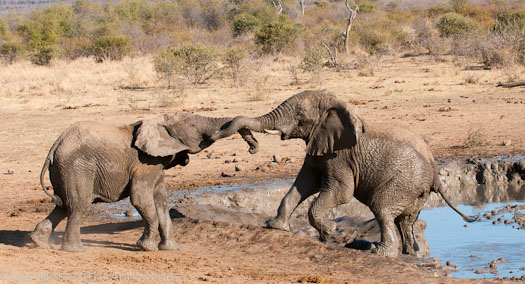
Bull elephants sparring at the watering hole

Bull elephants sparring at the watering hole

Three lions eating in the mud
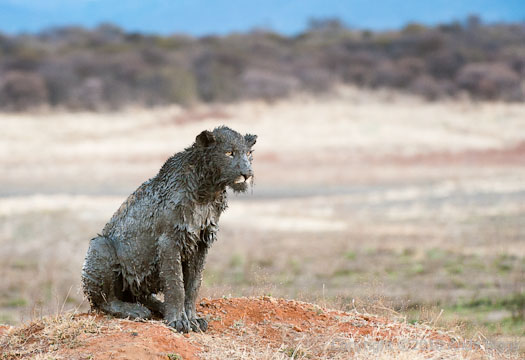
The lioness, all covered in mud from head to tail. Only her eyes and a little bit of her whiskers were showing
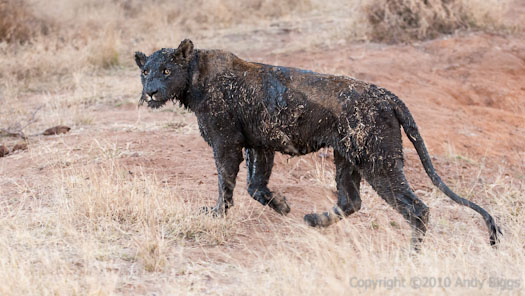
..and she scuttles off into the bush

Adele, Gerry and Leslie take a break
 Elephant,
Elephant,  Gerry Van Der Walt,
Gerry Van Der Walt,  Lion,
Lion,  Madikwe,
Madikwe,  Safari report,
Safari report,  Tuningi in
Tuningi in  Safari Reports
Safari Reports  Wednesday, September 8, 2010 at 10:43AM
Wednesday, September 8, 2010 at 10:43AM Leslie and I flew this morning to Gabarone, Botswana, and my friends Gerry and Adele van der Walt picked us up from the airport and drove us into Madikwe Game Reserve in South Africa. It is kind of ironic that I had to fly to another country in order to get to the reserve, but it was the fastest and most efficient way of getting here. There is a charter service from Johannesburg directly into Madikwe, but it sure is nice to take a big bird every now and then. We could have rented a car and driven the 3+ hours, but I would have not needed the car upon my arrival in Madikwe. It was actually less expensive and more efficient to just fly on a major airline instead. Oh, and I accumulated some more Star Alliance points. :-)
We stayed at Tuningi Safari Lodge, which is in the western side of Madikwe Game Reserve. Madikwe is a very interesting place, as it was once heavily grazed with cattle. In 1991 it was converted into a wildlife game reserve, and has all of the big 5 within its boundaries. The wildlife was relocated to Madikwe through Operation Phoenix, which was one of the largest wildlife translocation projects in the world. More than 8,000 animals from 28 species were released into Madikwe, which included elephant, rhino, lion, cheetah, wild dog, buffalo, hyena, giraffe and impala. The project was completed in 1997, and today there are more than 100 lions in the included 75,000 hectare property. Madikwe is a malaria-free area, which makes it a wonderful area for family safaris.
Tuningi Safari Lodge has 8 villas, and can accommodate a maximum of 16 people. Leslie and I absolutely loved the accommodations, and felt right at home during our 4 nights there. I would love to bring our sons there when they are older, but 2 years and 4 years old doesn’t work at this time.
After getting settled into the lodge, we headed out for the afternoon game drive. We pretty much spent our afternoon with elephants and rhinos (not a bad thing!) and watched some interesting and funny behavior. We were at one of the water holes and watch 2 family groups of white rhinos drink at the water’s edge. One large male spent the better part of a half an hour scratching his, uh, underside on a dead tree stump. After looking at the stump it was obvious that it has been used quite a bit for similar activities.
This afternoon was such a relaxing afternoon that I didn’t take too many photographs. I sat back, enjoyed my time with Leslie, and chatted with Grant Marcus, our awesome guide. Grant is also a great photographer, and one should visit Grant’s web site to see some of what he sees in and around Madikwe.
We headed back to camp after sunset, and we washed up and had a wonderful dinner around the fireplace in the lodge.

Our room at Tuningi
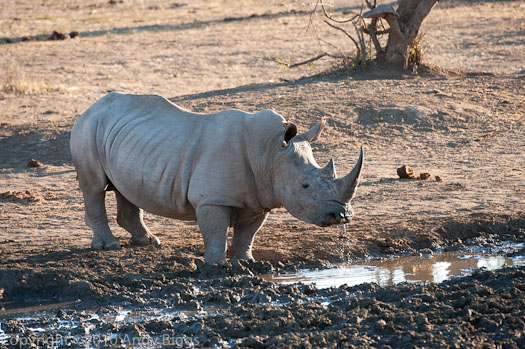
White rhino at the water's edge
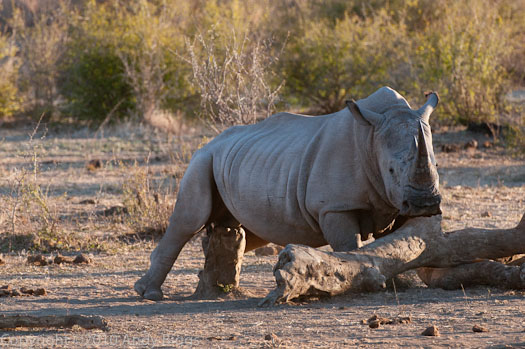
..now time to scratch, uh, the 'underside'
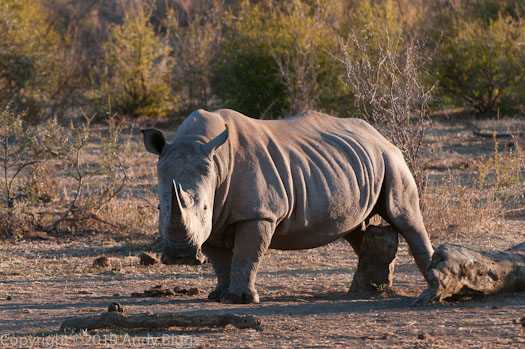
..and time to try another position
 Grant Marcus,
Grant Marcus,  Madiwke,
Madiwke,  Tuningi,
Tuningi,  safari in
safari in  Safari Reports
Safari Reports  Wednesday, September 1, 2010 at 07:54PM
Wednesday, September 1, 2010 at 07:54PM

Trip Leader: Randy Hanna
Come join us for an exciting photographic adventure to the Galapagos Islands. We have chartered a private 83-foot motor yacht for 20 people to this exciting location. We will visit many islands and will have the opportunity to photograph up close much of the wildlife on our 8 days and 7 nights aboard the M/Y Eric / Flamingo / Letty. We will have 2 naturalists on board and on shore for our group, which is an excellent naturalist-to-guest ratio! By park rules we are required to have 1 naturalist per 16 people, and we will have 1 per 10.
All other Galapagos trips miss the best light each day, but we will not. We will be on land in the best light, as this is a photography specific trip. This is an extremely important distinction between this trip and others. We also can take our time on our nature walks, allowing us to bring our tripods. Since we have a small and intimate group, we can take the time to get the shots that we need.
The cost of this trip is U.S. $5495, $5995 or $6395 per person depending on cabin level desired, double occupancy (but not inclusive of airfare to Guayaquil, Ecuador from your home). Refer to the boat diagram to determine which cabins will work best for your needs. The same rate applies for each participant regardless of whether they are doing photography and participating in the workshop, or not.
What's Included?
* Air transportation to and from the Galapagos islands from Guayaquil, Ecuador.
* 7 nights and 8 days aboard M/Y Eric / Flamingo / Letty
* Galapagos National Park Entrance Fee of $100
* 3 nights at the Grand Hotel Guayaquil at the beginning and end of islands visit.
* All meals and non-alcoholic drinks while on the ship
* Naturalists on board
* Snorkeling equipment
What is Not Included?
* Additional tips for staff such as guides
* International air to and from Ecuador and your home town
* Alcoholic beverages
* Laundry, phone and other items of a personal nature (yes we have laundry on board the vessel!)
* Trip Cancellation and Interruption Insurance (highly recommended)
* Meals not mentioned in itinerary (Guayaquil meals)
* Airport departure tax of $25
Click here to read comments from prior travelers and workshop participants.
Click here to read the day-by-day itinerary for this exciting trip, as well as the cabin layout.
What Do I Do Next?
Our groups are small, so space is limited. If this exciting trip has your name on it, if you're excited by the thought of becoming a member of this trip, then now is the time to register. Remember, there will be limited space available for this workshop. When they're spoken for, that's it. If you have any questions before registering, send us an e-mail with any inquiries to info@andybiggs.com.
 Wednesday, September 1, 2010 at 07:50PM
Wednesday, September 1, 2010 at 07:50PM Sorry for the delay in getting the last part of my safari online. Leslie and I spent 4 nights in Madikwe at Tuningi Safari Lodge with some friends, and during that time we didn't have much time to process photos or post anything online. And then, of course, when we arrived home daily life got in the way.
I will post the remainder of my safari journal online in the next few days, as well as a summary from the African Wildlife Boot Camp. Sorry for the delay!